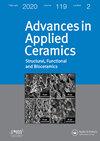城市污泥制备多孔陶粒及其结构特性研究
IF 1.6
4区 材料科学
Q3 MATERIALS SCIENCE, CERAMICS
引用次数: 0
摘要
摘要本文以城市污泥为主要原料,制备了一种多孔陶粒。以50 wt-%的城市污泥、10 wt-%的城市生活垃圾焚烧底灰、45 wt-%的废玻璃粉为原料,烧结温度为900℃,保温时间为30 min,合成的最佳陶粒1 h吸水率为51.53%,表观孔隙率为64.14%,孔隙体积为0.671 mL g - 1。在烧结过程中,废玻璃粉产生大量液相,包裹有机物产生的气体,在陶瓷颗粒内部形成多孔结构。同时,二氧化硅与铝结合形成蓝晶石,蓝晶石构成了具有一定强度的陶瓷颗粒的基本骨架。此外,氧化硅和硅酸钙生成硅灰石也提高了陶瓷颗粒的耐腐蚀性。以制备的多孔陶粒为底物,酸与柠檬酸钠复合改性的多孔陶粒的吸附量为3.1 mg g−1。多孔陶瓷对氨氮的吸附动力学符合准二级动力学模型,吸附等温线模型符合Langmuir模型。研究结果为固体废物资源化利用与后期应用的整合提供了理论基础。关键词:城市污泥;表观孔隙率;多孔陶粒;本研究由国家重点研发计划资助[批准号:2019YFC1904605]。本文章由计算机程序翻译,如有差异,请以英文原文为准。
Preparation of porous ceramsite from municipal sludge and its structure characteristics
ABSTRACTIn this paper, the municipal sludge was used as the main raw material to prepare a kind of porous ceramsite. The porous ceramsite composition of 50 wt-% of municipal sludge, 10 wt-% of municipal solid waste incineration bottom ash, 45 wt-% of waste glass powders, sintering temperature of 900°C and holding duration of 30 min. The best of the ceramsite synthesised had 1-h water absorption capacity of 51.53%, apparent porosity of 64.14% and pore volume 0.671 mL g−1. During the sintering process, the waste glass powders generated a large amount of liquid phase, wrapt the gas produced by organic matter, and formed a porous structure inside the ceramic particles. At the same time, the silica and aluminium were combined to form Kyanite, which constitutes the basic skeleton of the ceramic particles showing a certain strength. Besides, silicon oxide and calcium silicate generated Wollastonite improving the corrosion resistance of ceramic particles as well. The adsorption capacity of the prepared porous ceramsite modified by acid combined with sodium citrate was 3.1 mg g−1 using the prepared porous ceramsite as substrate. The adsorption kinetics of ammonia nitrogen by porous ceramics conforms to the quasi-second-order kinetic model, and the adsorption isotherm model conforms to the Langmuir model. The findings lay a theoretical foundation for the integration of resource utilisation of solid waste and later application.KEYWORDS: Municipal sludgeapparent porosityporous ceramsitepore structureresource recovery Disclosure statementNo potential conflict of interest was reported by the author(s).Additional informationFundingThis study was funded by the National Key Research and Development Program of China [grant number 2019YFC1904605].
求助全文
通过发布文献求助,成功后即可免费获取论文全文。
去求助
来源期刊

Advances in Applied Ceramics
工程技术-材料科学:硅酸盐
CiteScore
4.40
自引率
4.50%
发文量
17
审稿时长
5.2 months
期刊介绍:
Advances in Applied Ceramics: Structural, Functional and Bioceramics provides international coverage of high-quality research on functional ceramics, engineering ceramics and bioceramics.
 求助内容:
求助内容: 应助结果提醒方式:
应助结果提醒方式:


